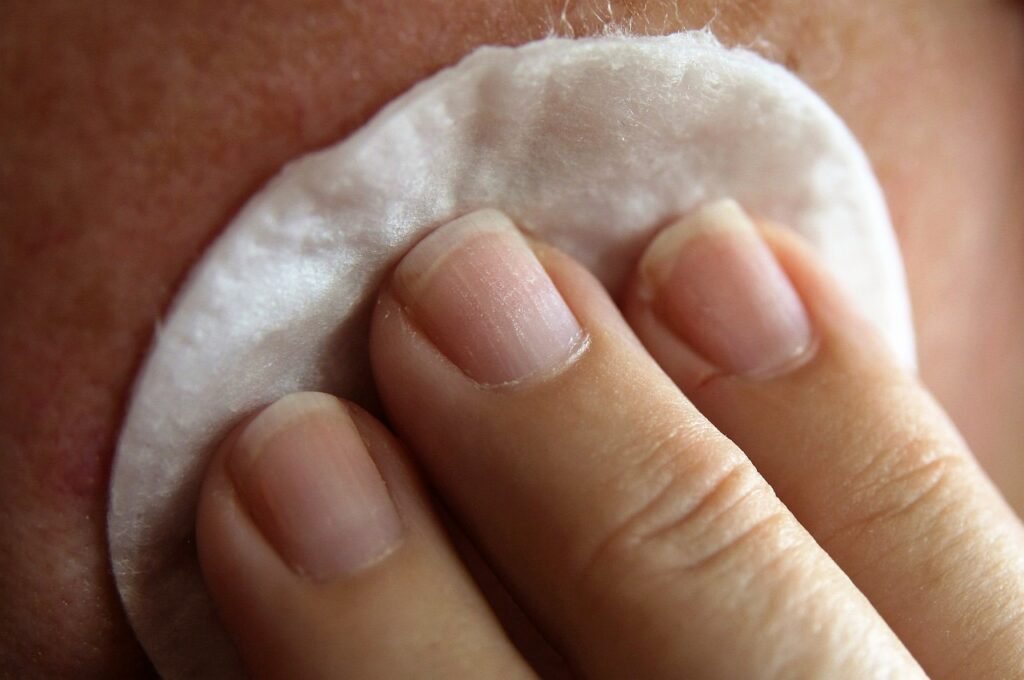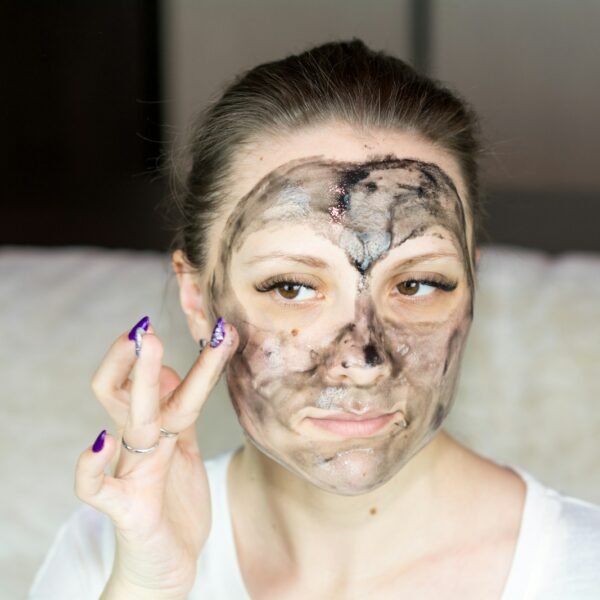Let’s address the elephant in the room “Should salicylic acid burn?” Many of us have applied this popular ingredient and felt an uncomfortable burning sensation, leading us to wonder if that’s just part of the process.
There’s a common belief that if a skincare product stings, it must be working. I remember a friend of mine eagerly trying out a new topical salicylic acid, convinced that the intense tingling she felt was a sign it was banishing her acne.
But instead of clearer skin, she ended up with irritation and redness, questioning if she should keep using it.
In this post, we’ll explore salicylic acid and how it works and help you determine whether that burning sensation is normal or a sign of trouble.

What is Salicylic Acid?
Salicylic acid is a beta hydroxy acid (BHA) widely used in skincare, especially for treating acne.
It’s derived from willow bark and works by exfoliating the skin, penetrating deep into the pores to remove dead skin cells and excess oil. This action helps to prevent clogged pores, reduce acne, and improve overall skin texture.
You might be thinking, “That sounds great, but why does it sometimes burn?” Good question!
How Salicylic Acid Works
Understanding how salicylic acid works is key to answering the question: Should salicylic acid burn?
This ingredient is a powerhouse in skincare, particularly for those struggling with acne and clogged pores.
Here is how it works:
- Penetrating Deep into Pores: Salicylic acid is oil-soluble, which means it can penetrate deep into your skin’s pores. Unlike water-soluble acids like alpha hydroxy acids that only exfoliate the surface, salicylic acid gets down to the root of the problem, helping to clear out the debris and excess oil that can cause acne.
- Exfoliating and Removing Dead Skin Cells: One of the primary benefits of salicylic acid is its ability to exfoliate the skin. It works by dissolving the bonds between dead skin cells, making it easier to shed them naturally. This exfoliation process helps prevent clogged pores, reduces the appearance of blackheads and whiteheads, and promotes a smoother skin texture.
- Reducing Inflammation: Salicylic acid also has anti-inflammatory properties, which can help to soothe irritated skin and reduce redness. This is particularly beneficial for those with acne-prone skin, as inflammation often accompanies breakouts.
- Balancing Oil Production: For those with oily skin, salicylic acid can help regulate oil production. By keeping the pores clear and reducing excess oil, it creates a more balanced skin environment, which is less prone to acne and breakouts.
Addressing the Burning Sensation
So, should salicylic acid burn? The answer is, it depends. A mild tingling sensation can be normal, especially if you’re new to using the product or if the concentration is higher than what your skin is accustomed to.
However, if the burning is intense or leads to significant redness and irritation, it’s a sign that the product may be too strong for your skin, or that you need to adjust how often you use it.

Normal vs. Abnormal Reactions to Salicylic Acid
Now that we have a basic understanding of how salicylic acid works, let’s address the difference between normal vs abnormal reactions to salicylic acid. It’s essential to establish this so you’re using this ingredient safely and effectively.
- Normal Reactions
When you first start using salicylic acid, some initial sensations are to be expected. These can include:
- Mild Tingling: A slight tingling sensation is common, especially if you’re new to salicylic acid or using a higher concentration. This tingling usually subsides after a few minutes and is a sign that the acid is penetrating your pores and starting to work.
- Light Redness: Some temporary redness may occur, particularly if you have sensitive skin. This is typically short-lived and should diminish as your skin adjusts to the product.
- Dryness or Peeling: As salicylic acid exfoliates your skin, you might experience some dryness or light peeling. This is part of the process of shedding dead skin cells and revealing fresher skin beneath.
These reactions are generally considered normal and should improve as your skin builds tolerance.
- Abnormal Reactions
While mild reactions are normal, certain signs indicate that salicylic acid might be too harsh for your skin. These include:
- Intense Burning: If the burning sensation is severe and persists, it’s a clear sign that something is wrong. Intense burning can indicate that the product concentration is too high for your skin or that you’re applying it too frequently.
- Severe Redness and Irritation: Significant redness, inflammation, or swelling are abnormal reactions. This level of irritation suggests that your skin barrier is being compromised.
- Persistent Dryness and Peeling: While some dryness is normal, persistent or severe peeling is a sign that your skin is overly dry and irritated. This can lead to further complications, such as increased sensitivity or even breakouts.
- Blisters or Rash: The appearance of blisters, rash, or any type of allergic reaction is a red flag. Discontinue use immediately if you experience these symptoms and consult with a dermatologist.
What to Do If You Experience Abnormal Reactions
If you notice any of these abnormal reactions, it’s crucial to take immediate action to prevent further damage to your skin:
- Stop Using the Product: Discontinue the use of salicylic acid if you experience severe symptoms of a chemical burn.
- Wash face: Immediately wash your face with a gentle cleanser
- Soothe Your Skin: Use a gentle, fragrance-free moisturizer to help calm and repair your skin’s moisture barrier.
- Consult a Professional: If the irritation persists or worsens, seek medical help from a healthcare professional. They can recommend alternative acid exfoliants which might be better suited to your skin type.

Best Practices for Using Salicylic Acid
Whether you’re a seasoned skincare enthusiast or new to the world of acids, these tips will help you navigate the best way to clearer, smoother skin without experiencing unnecessary discomfort.
- Start Slow and Low
When incorporating salicylic acid into your skincare routine for the first time, it’s essential to start with a low concentration and gradually increase as your skin builds tolerance.
This approach allows your skin to adjust to the new product gradually, minimizing the risk of skin irritation and burning.
Begin with products containing lower concentrations of salicylic acid (around 0.5% to 2%) and use them a few times a week.
As your skin becomes accustomed to the acid, you can gradually increase the frequency of use and opt for higher concentrations if needed.
- Patch Test
Before applying salicylic acid to your entire face, it’s wise to conduct a patch test to assess how your skin will react.
Apply a small amount of the product to a discreet area of skin, such as the inner forearm or behind the ear, and wait for 24 hours to observe any adverse reactions.
If you experience significant irritation or burning during the patch test, it’s best to avoid using the product on your face.
- Moisturize and Hydrate
Salicylic acid can be drying to the skin, especially when used at higher concentrations or too frequently. To counteract this, it’s essential to moisturize and hydrate your skin regularly.
Choose a gentle, non-comedogenic moisturizer that won’t clog your pores and apply it liberally after using salicylic acid. Additionally, drink plenty of water to keep your skin hydrated from the inside out.
- Use Sun Protection
Salicylic acid can increase your skin’s sensitivity to the sun, making it more susceptible to sunburn and damage.
To protect your skin, always apply a broad-spectrum sunscreen with an SPF of 30 or higher during the day, even if you’re not planning to spend extended periods outdoors.
Reapply sunscreen every two hours, especially if you’re sweating or swimming, to ensure continuous protection.
- Listen to Your Skin
Lastly, listen to your skin and adjust your skincare routine accordingly. If you experience persistent burning, redness, or irritation when using salicylic acid, it may be a sign that the product is too harsh for your skin.
In such cases, discontinue use and switch to milder alternatives, such as gentle exfoliants or soothing skincare products.
Debunking Common Misconceptions About Salicylic Acid
Myth 1: If It Doesn’t Burn, It’s Not Working
One of the most pervasive myths about salicylic acid is that it must burn or sting to be effective. This couldn’t be further from the truth!
While some tingling or mild irritation is normal, especially when you’re first starting out, intense burning or discomfort is a sign that the product may be too harsh for your skin.
Myth 2: More Is Always Better
Another misconception is that using a higher concentration of salicylic acid will deliver better results. In reality, the opposite may be true.
Higher concentrations can increase the likelihood of irritation and burning, especially if your skin is sensitive.
It’s essential to start with a lower concentration and gradually increase as your skin builds tolerance.
Myth 3: It Should Burn to Get Rid of Acne
Many people believe that the burning sensation from salicylic acid is necessary to banish acne.
While salicylic acid can be effective in treating acne and preventing breakouts, it shouldn’t cause significant discomfort or pain.
If you’re experiencing intense burning or irritation, it’s a sign that something is wrong.
Myth 4: It’s Normal for Salicylic Acid to Cause excessive Peeling
Peeling is often seen as a sign that salicylic acid is doing its job, but excessive or persistent peeling can be a sign of over-exfoliation and skin damage.
While some light shedding of dead skin cells is normal, especially when you first start using salicylic acid, it shouldn’t result in significant peeling or flaking.
If you’re experiencing excessive peeling, dial back your use of salicylic acid and focus on gentle, hydrating skincare products to repair your skin barrier.
Bottom Line
In conclusion, salicylic acid can be a valuable addition to your skincare routine, helping to treat acne, unclog pores, and improve overall skin texture. However, it’s essential to use it safely and responsibly to avoid unnecessary face burns or serious side effects.
Remember, the goal of using salicylic acid is to improve your skin, not to cause discomfort or damage. By recognizing the difference between normal and abnormal reactions, you can adjust your skincare routine accordingly and maintain healthy, glowing skin.





Leave a Reply